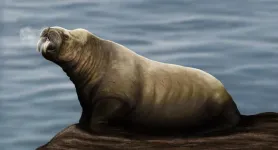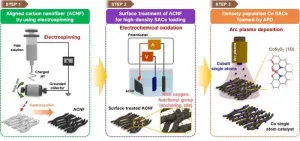(Press-News.org) CORVALLIS, Ore. – Safeguarding places to hang ten and shoot the curl is an opportunity to simultaneously mitigate climate change, fuel tourism and help surrounding ecosystems, new research has shown.
“There is a growing conservation movement regarding coastal areas that host surf breaks,” said Jacob Bukoski of Oregon State University, one of the study’s co-authors. “Earlier research showed that surf breaks tend to be biodiversity hotspots, but no one had looked at the stocks of carbon held within these ecosystems – carbon that could drive climate change if disturbed and lost.”
In study published today in Conservation Science & Practice, Bukoski and collaborators identified more than 88 million tonnes of “irrecoverable” carbon in the land-based ecosystems surrounding 3,602 surf breaks around the globe.
Surf breaks, nearshore areas whose special mix of coastal and seafloor characteristics creates waves surfers crave, are often found in or near ecosystems that are conservation priorities, such as coral reefs and mangrove forests.
Irrecoverable carbon is defined as carbon stored in nature that, if lost, could not be replenished within 30 years. Carbon sequestration is a key component of climate change mitigation.
Bukoski, a faculty member in the OSU College of Forestry, stresses that the study did not take into account the significant, but harder to quantify, carbon stocks in the marine portion of surf break areas.
The scientists looked at 28,500 square kilometers of watersheds that drain into surf areas. Their analysis showed that more than 17 million tonnes of irrecoverable surf break carbon are found in places categorized as key biodiversity areas but lacking any kind of formal protection. Just 3% of surf breaks are both formally protected and in a key biodiversity area.
Irrecoverable carbon density in surf ecosystems tends to be highest in the tropics and gets lower farther from the equator, with the exception of coastal forests in the Pacific Northwest.
“Temperate broadleaf and mixed forests and temperate conifer forests combined to hold nearly one-quarter of the carbon we found,” said Bukoski, who collaborated with scientists from Conservation International, Save the Waves Coalition, California State University, Channel Islands, and Arizona State University.
Oregon ranks second among U.S. states in irrecoverable surf break carbon at almost 3.5 million tonnes. California, at just under 7 million tonnes, leads the way, and rounding out the top 10 are North Carolina, Florida, Texas, Washington, Virginia, New Jersey, South Carolina and Massachusetts.
Increasingly, surf breaks are being recognized as socio-environmental phenomena that can bring opportunity for sustained benefits for local communities, the authors say. They point to the potential intersection of the surf tourism industry, valued at as much as $65 billion globally, and the carbon offset market, where credits are trading at a price of about $10 per tonne of carbon dioxide.
“Despite their high and multifaceted value, surf breaks and their surrounding environments face all kinds of threats, including coastal development, degradation of habitats, and impacts from climate change like rising sea levels,” Bukoski said. “When carbon-dense ecosystems are converted to other uses, they pump out large amounts of carbon dioxide into the atmosphere. Expanded conservation of surf ecosystems – both their marine and onshore components – could provide a range of benefits in addition to biodiversity conservation and climate mitigation.”
Coastal estuaries, he explains, help with nutrient cycling, control sedimentation and act as nurseries for young fish. Healthy upland ecosystems reduce erosion, which means better habitats and also reduced illness risk to surfers because of improved water quality.
“Coral reefs shape surf breaks and provide fishing grounds, offer non-surfing recreational opportunities such as diving, and protect shorelines,” Bukoski said. “And just as importantly, ecosystems associated with surf breaks are culturally and spiritually valuable to communities around the world.”
He notes that irrecoverable carbon constitutes only a fraction of the total carbon stored in surf ecosystems. Given resource and time constraints, irrecoverable is the type of carbon that should be prioritized for conservation, “but any carbon lost to ecosystem conversion will affect the climate.”
“Our results suggest a significant opportunity for surf conservation to strengthen protection of climate-critical carbon stocks,” Bukoski said. “At the end of the day, we should be shredding waves, not ecosystem carbon.”
END
Protecting surf breaks mitigates climate change, helps coastal communities, analysis finds
2024-08-13
ELSE PRESS RELEASES FROM THIS DATE:
New species of extinct walrus-like mammal discovered in the North Atlantic
2024-08-13
A new discovery by a team of paleontologists, led by Dr. Mathieu Boisville (University of Tsukuba, Japan), has uncovered a new species of the extinct genus Ontocetus from the Lower Pleistocene deposits in the North Atlantic. This species, named Ontocetus posti, displays surprising similarities in feeding adaptations to the modern walrus (Odobenus rosmarus), highlighting an intriguing case of convergent evolution. The research is published in the open access journal PeerJ Life & Environment.
The fossils ...
Empowering women – a key to both sustainable energy and gender justice
2024-08-13
Involving women in implementing solar energy technologies in developing countries not only has great climate impact. A new study published in Nature Energy and carried out by researchers from Chalmers University of Technology, Sweden, shows that empowering women through energy care work can change unjust, gendered norms and long-lived injustices.
Unlike going from fossil to renewable fuels within the transport sector, transitioning to renewable energy for electricity production is often done at the local level due to decentralised energy providers. Around the world, there are community-led programmes that provide solar, wind and hydro power, as alternative, greener energy sources. ...
Delivery robots’ green credentials make them more attractive to consumers
2024-08-13
PULLMAN, Wash. – The smaller carbon footprint, or wheel print, of automatic delivery robots can encourage consumers to use them when ordering food, according to a Washington State University study.
The suitcase-sized, self-driving electric vehicles are much greener than many traditional food delivery methods because they have low, or even zero, carbon emissions. In this study, participants who had more environmental awareness and knowledge about carbon emissions were more likely to choose the robots as ...
Mayo Clinic offers new innovative therapy to treat atrial fibrillation
2024-08-13
ROCHESTER, Minn. — Cardiologists in Mayo Clinic's Heart Rhythm Clinic are using a new innovative energy source to safely and successfully treat a common type of heart arrhythmia. The therapy, called pulsed field ablation (PFA), has received Food and Drug Administration (FDA) approval and represents a significant milestone in treating atrial fibrillation (AFib).
The irregular and often very rapid heart rhythm of AFib can lead to blood clots in the heart, increasing a patient's risk of stroke. Clinicians can use medication and therapies to help reset the heart rhythm, but some patients have AFib that ...
Changing food consumers' choices may help cut greenhouse gases
2024-08-13
Planet-warming greenhouse gas emissions associated with the global food supply chains induced by diets could fall by 17% if people change their food choices towards more plant-based diets, a new study reveals.
Researchers believe that a currently over-consuming 56.9% of the global population would save 32.4% of global dietary emissions by changing their diet to the planetary health diet proposed by the EAT-Lancet Commission.
Publishing their findings today (13 Aug) in Nature Climate Change, an international group of researchers note that a diet switch to the planetary health diet would balance the ...
Significant link found between heme iron, found in red meat and other animal products, and type 2 diabetes risk
2024-08-13
Key points:
Researchers identified a significant link between heme iron—iron found in red meat and other animal products —and risk of type 2 diabetes (T2D), as well as the metabolic pathways underlying the link.
Non-heme iron—iron found in plant-based foods—was not associated with risk of T2D.
The study suggests that cutting down on heme iron from red meat and adopting a plant-rich diet can help lower diabetes risk. And it raises concerns about the addition of heme to increasingly popular plant-based meat alternatives.
Boston, MA—Higher intake ...
Older adults’ life satisfaction varies by immigrant status, living arrangement and social disposition
2024-08-13
TORONTO, ON – Do older adults who live alone feel less satisfied with their lives? A new analysis of about 12,000 respondents aged 65 and older reveals that what matters for Canadian older adults’ life satisfaction is not living alone per se. Rather personality-based social dispositions play a key role in how older adults feel about living alone. In addition, the role these dispositions play tend to differ between Canadian-born and immigrant older adults.
The researchers found that despite the existence ...
Say ‘aah’ and get a diagnosis on the spot: is this the future of health?
2024-08-13
A computer algorithm has achieved a 98% accuracy in predicting different diseases by analysing the colour of the human tongue.
The proposed imaging system developed by Iraqi and Australian researchers can diagnose diabetes, stroke, anaemia, asthma, liver and gallbladder conditions, COVID-19, and a range of vascular and gastrointestinal issues.
Engineering researchers from Middle Technical University (MTU) and the University of South Australia (UniSA) achieved the breakthrough in a series of experiments where they used 5260 images to train machine learning algorithms to detect tongue colour.
Two ...
Rapid removal of emerging endocrine disruptors in wastewater using high-performance single-atom catalysts
2024-08-13
Bisphenols are widely used as the main raw material for plastics such as receipts, water bottles, water containers, and vinyl due to their heat-resistant and mechanochemical properties. Among bisphenols, bisphenol A (BPA) that we often refer to as an "endocrine-disrupting chemicals" has been linked to adverse effects on reproduction, development, intelligence, and various metabolic diseases. Bisphenol F (BPF), a recently developed alternative to BPA Bisphenol A has also been reported in the literature to cause neurological disruption and various health risks.
Dr. Jong Min Kim of the Materials Architecturing ...
Starvation and adhesion drive formation of keratinocyte patterns in skin
2024-08-13
Cell–cell adhesion-induced patterning in keratinocytes can be explained by just starvation and strong adhesion, Hokkaido University researchers find.
Fingerprints are one of the best-recognised examples of pattern formation by epithelial cells. The primary cells in the epithelium are the keratinocytes, and they are known to form patterns at the microscopic and macroscopic levels. While factors affecting this pattern formation have been reported, the exact mechanisms underlying the process are still not fully understood.
A team of researchers, led by Associate ...






